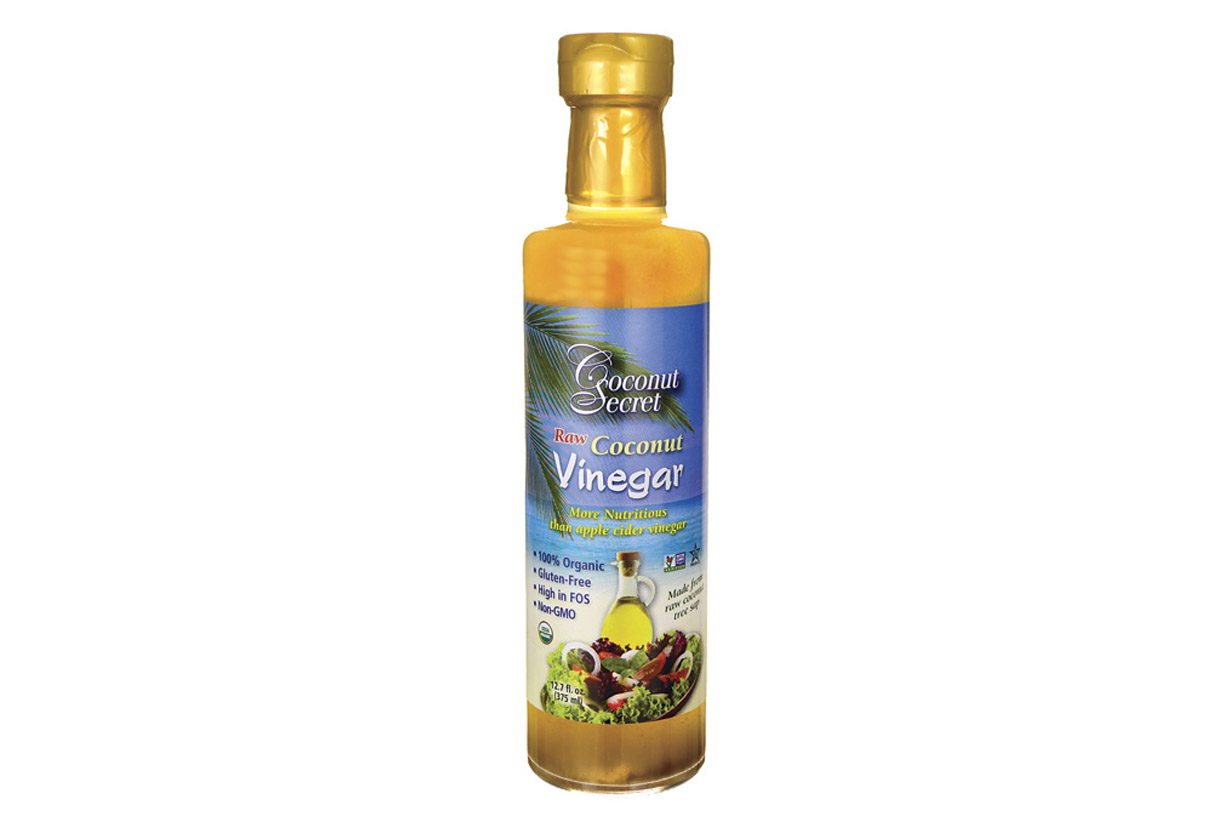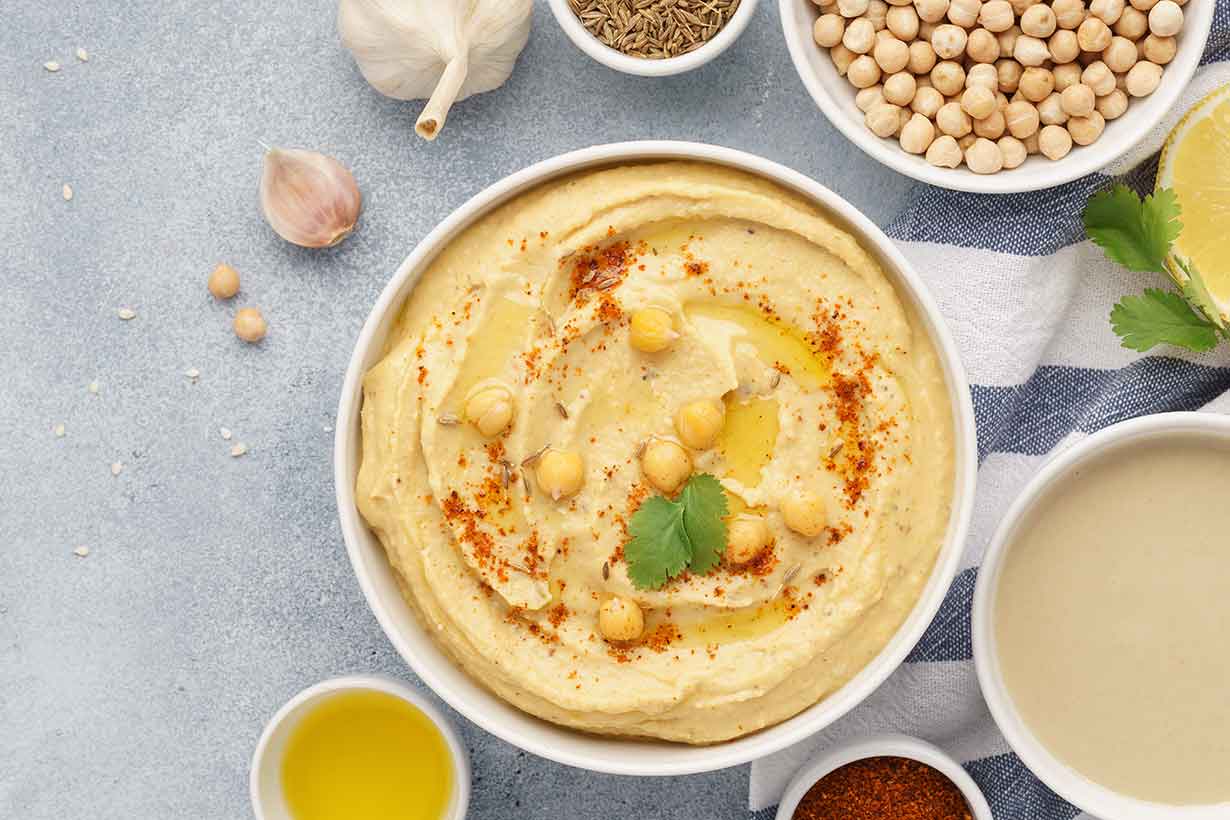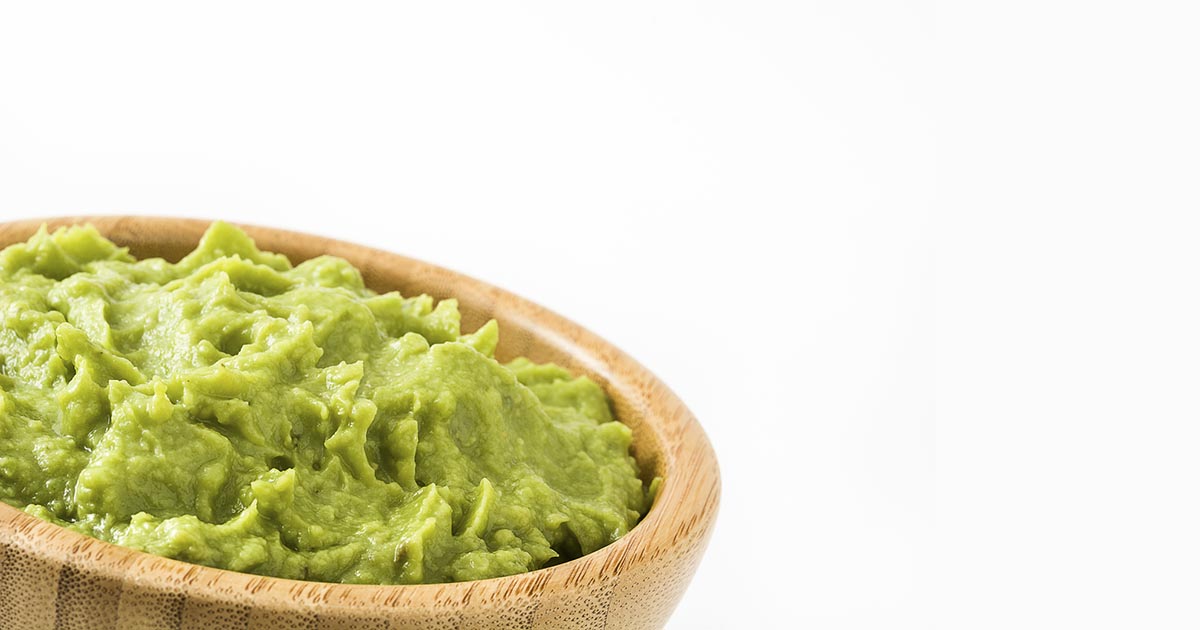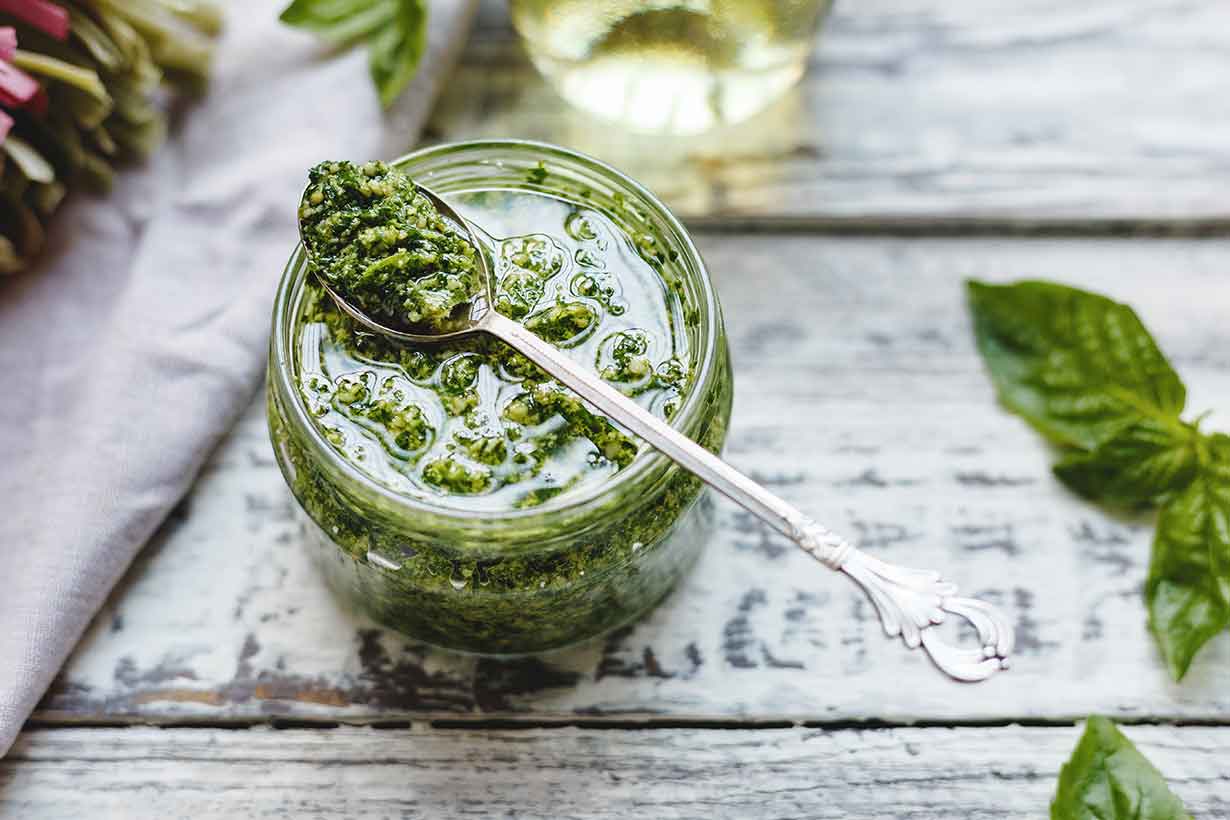We can use condiments to enhance the taste of a wide variety of foods.
This article provides a list of 36 popular condiments from around the world alongside a brief guide and their basic nutritional values.
Some of these condiments are common and some are lesser-known.
Whether you prefer something a little bit spicy, salty, sour, or creamy, there is something for everyone in this list.
Table of contents
- 1) Aioli
- 2) Apple Cider Vinegar
- 3) Bearnaise Sauce
- 4) Black Pepper
- 5) Coconut Aminos
- 6) Coconut Vinegar
- 7) Cream Cheese
- 8) Fish Sauce
- 9) Gochujang
- 10) Guacamole
- 11) Harissa
- 12) Hollandaise Sauce
- 13) Hot Sauce
- 14) Hummus
- 15) Ketchup
- 16) Kimchi
- 17) Kyopolou
- 18) Lemon Juice
- 19) Malt Vinegar
- 20) Mayonnaise
- 21) Muhammara
- 22) Mustard
- 23) Nutella
- 24) Peanut Butter
- 25) Pesto
- 26) Ponzu Sauce
- 27) Red Wine Vinegar
- 28) Sauerkraut
- 29) Salsa
- 30) Sesame Oil
- 31) Sour Cream
- 32) Ssamjang
- 33) Tahini
- 34) Tamari Sauce
- 35) Wasabi
- 36) White Pepper
- Final Thoughts
1) Aioli
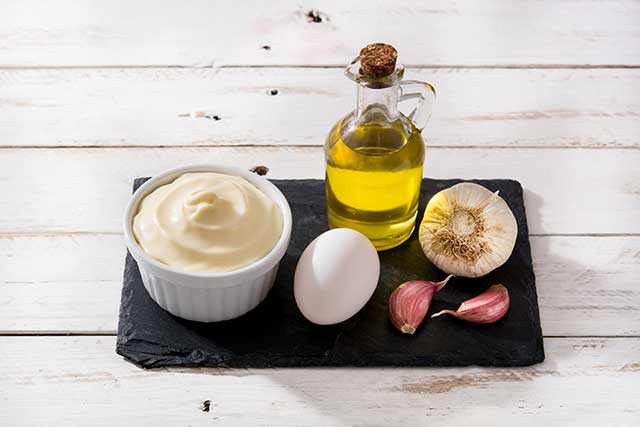
Aioli is a Mediterranean condiment that traditionally features egg yolk, garlic, extra virgin olive oil, and salt.
This famous sauce offers a creamy texture and a flavorful taste, and garlic has a strong influence on traditional recipes.
Generally, aioli is served as a side with vegetables, meat, or olives, and it is popular as a dipping sauce too.
A typical tablespoon serving of aioli offers the following profile (1):
- Calories: 97 kcal
- Carbohydrate: 0.3 g
- Fiber: 0 g
- Sugars: 0 g
- Fat: 11 g
- Protein: 0.3 g
- Sodium: 44 mg
Since the main ingredients of aioli are olive oil and garlic, the sauce offers good amounts of monounsaturated fat and polyphenols (2, 3, 4).
2) Apple Cider Vinegar
Apple cider vinegar is a very sour-tasting vinegar that works well in various recipes and as a tenderizing agent for meat.
While the purported health properties of apple cider vinegar are often exaggerated, it does have some potential benefits.
For example, apple cider vinegar contains large amounts of acetic acid.
Research suggests that acetic acid may help to (slightly) reduce the postprandial blood sugar response after a meal. However, existing studies advise that more extensive trials are necessary to understand these potential effects better (5, 6).
Additionally, apple cider vinegar can help to improve the taste of a variety of dishes. For one thing, it offers a unique sour and tangy flavor, and the acidity of the vinegar also helps to tenderize any tough cuts of meat.
Nutritionally, a tablespoon serving of apple cider vinegar provides (7):
- Calories: 3 kcal
- Carbohydrate: 0.1 g
- Fiber: 0 g
- Sugars: 0.1 g
- Fat: 0 g
- Protein: 0 g
- Sodium: 1 mg
3) Bearnaise Sauce
Bearnaise sauce is a traditional French sauce made by combining egg yolks with clarified butter and white wine vinegar. The sauce also contains a range of seasonings such as pepper and tarragon.
Due to the egg yolk content, the sauce even manages to offer a small amount of protein.
Bearnaise sauce is traditionally served alongside meat (especially steak) or fish-based dish. It provides the following basic nutrition profile per 47-gram serving (8):
- Calories: 228 kcal
- Carbohydrate: 1.0 g
- Fiber: 0.2 g
- Sugars: 0.2 g
- Fat: 25 g
- Protein: 1.4 g
- Sodium: 185 mg
4) Black Pepper
Black pepper is among the most widely used condiments in the world, and this spice offers a distinctive hot and peppery taste.
The heat from black pepper is courtesy of the piperine content of peppercorn. On this note, piperine has some interesting potential benefits.
For instance, research demonstrates that piperine improves the bioavailability of various beneficial compounds in food.
Firstly, human trials show that piperine enhances the bioavailability and absorption of curcumin. Curcumin is a chemical compound contained within turmeric (9).
Secondly, piperine also appears to improve the bioavailability of polyphenols such as resveratrol, found in wine, and tea polyphenols such as EGCG (10, 11).
Since we only need to use a dash of black pepper, it is an insignificant source of calories and nutrients.
5) Coconut Aminos
Coconut Aminos is a unique and relatively new condiment.
To make this sauce, the producers mix sap from the coconut tree with sea salt and allow it to age/ferment.
While it looks like soy sauce and shares a slightly similar salty flavor, the taste is quite a lot different.
For one thing, Coconut Aminos is milder in flavor and has a slightly different taste, with hints of sweetness.
Overall, it works well as a substitute for soy sauce, but it might not be the right fit for someone who enjoys the strong flavor condiments like traditional soy or tamari sauce offer.
Coconut Aminos can be used to flavor a variety of dishes, and you can read a full guide on it here.
One teaspoon serving of Coconut Aminos supplies the following nutritional profile (12):
- Calories: 4 kcal
- Carbohydrate: 1 g
- Fiber: 0 g
- Sugars: 0 g
- Fat: 0 g
- Protein: 0 g
6) Coconut Vinegar
There are many different kinds of vinegar available to buy, but one of the lesser-known varieties is coconut vinegar.
With an acidic and slightly sweet taste profile, it can add an exciting and tasty flavor to our food, and it works well in Asian-style cooking and curries.
Similar to all vinegar, it should also have slight benefits for blood-sugar regulation since it contains a reasonable amount of acetic acid (13).
For an in-depth guide to coconut vinegar, see this guide.
7) Cream Cheese
Cream cheese is a fresh cheese produced from milk and cream. It is also delicious and offers some of the same benefits as regular cheese.
For instance, cream cheese is a good source of calcium, phosphorus, and vitamin A. The basic nutrition profile for a two-tablespoon (30-gram) serving of cream cheese are as below (14):
- Calories: 102 kcal
- Carbohydrate: 1.6 g
- Fiber: 0 g
- Sugars: 1.1 g
- Fat: 10 g
- Protein: 1.8 g
- Sodium: 91 mg
Cream cheese is very versatile as a condiment, and we can use it as a topping on a wide variety of foods.
It also works well as a spread in a similar way to butter, and it is particularly popular paired with baked potatoes.
Learn more: Cream Cheese: Is It a Healthy Choice?
8) Fish Sauce
Fish sauce is a condiment that enjoys popularity in East and South-East Asia, and it adds a lot of flavor to food.
While fish sauce sometimes features in recipes, it is also popular as a dip, especially in Thai and Vietnamese cuisine.
The sauce has a liquid consistency similar to soy sauce, and it offers a complex and robust flavor, which is both salty and pungent.
Producing fish sauce involves salting and then fermenting fish (often anchovies) for 1-2 years (15).
One recent study found that traditional Korean fish sauce contained a range of different bacterial species thought to have beneficial effects for digestive health. These bacterial strains included Lactobacillus, Weisella, Leuconostoc, and Terragenococcus (16).
One caveat, though: fish sauce is a significant source of salt, so it may be unsuitable for individuals trying to lower their sodium intake.
Nutritionally, a typical tablespoon serving (18g) of fish sauce contains (17):
- Calories: 6 kcal
- Carbohydrate: 0.66 g
- Fiber: 0 g
- Sugars: 0 g
- Fat: <0.01 g
- Protein: 0.91 g
- Sodium: 1413 mg
See this complete nutritional guide to fish sauce for more information.
9) Gochujang
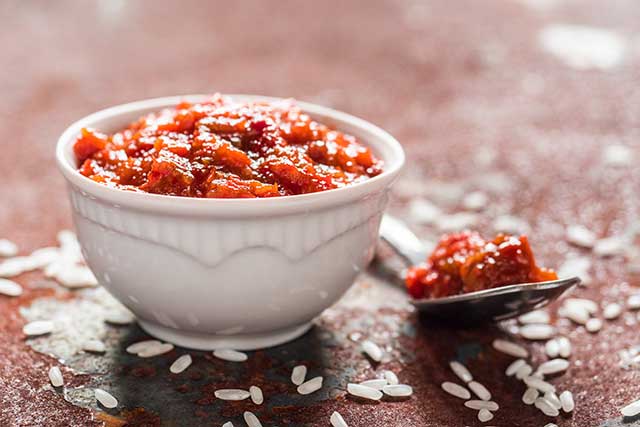
Gochujang is a Korean fermented condiment made from spicy peppers, salt, fermented soy, rice vinegar, and small amounts of glutenous rice.
The English translation of gochujang is red chili paste, and it has a thick paste-like consistency.
Gochujang has a mildly sweet, salty, and spicy flavor, and it can add deep flavor to food either as part of the ingredients or as a dipping sauce.
In Korean cuisine, gochujang is a common ingredient in everything from rice dishes to meat stews (18).
This condiment also contains several ingredients that could have potential benefits. These ingredients include capsaicin and fermented soy, which is a source of probiotics and, potentially, vitamin K2 (19).
Per tablespoon (15-gram) serving, gochujang offers (20):
- Calories: 30 kcal
- Carbohydrate: 6 g
- Fiber: 0 g
- Sugars: 6 g
- Fat: 0 g
- Protein: 1 g
- Sodium: 96 mg
10) Guacamole
There are lots of great things about avocados, and one of their major plus points is that they provide us with guacamole.
Guacamole is a Mexican condiment that exists in many different varieties, but the traditional recipe is avocado, salt, and lime juice.
Since the main ingredient in guacamole is avocado, this condiment has similar benefits to the whole fruit.
Notably, guacamole provides a wealth of healthy fats, fiber, and high concentrations of potassium, vitamin C, and B vitamins (21).
A one-ounce (28.5 g) serving of guacamole provides (22);
- Calories: 45 kcal
- Carbohydrate: 2.4 g
- Fiber: 1.9 g
- Sugars: 0.2 g
- Fat: 4.1 g
- Protein: 0.6 g
- Sodium: 127 mg
For more on guacamole, see this complete guide.
11) Harissa
Harissa is another type of hot chili paste, and it has a healthy ingredients profile of chili peppers, garlic, olive oil, and a variety of toasted spices.
This spicy paste originates from North Africa, where it is a staple ingredient in the food. On this note, harissa also has the recognition of being ‘Tunisia’s national condiment.’
Harissa can be used in soups and stews, as a dip, or for marinating meats and seafood.
Per tablespoon serving, harissa’s basic nutrition profile is as follows (23):
- Calories: 46 kcal
- Carbohydrate: 3.8 g
- Fiber: 1.8 g
- Sugars: 0.1 g
- Fat: 3.5 g
- Protein: 0.9 g
For more information, see this complete guide to harissa:
Harissa Paste: Ingredients, Nutrition, and Uses
12) Hollandaise Sauce
Hollandaise sauce is another egg yolk and butter-based French condiment.
However, unlike bearnaise sauce, it contains lemon juice rather than vinegar, and it is mostly seasoned with salt.
This condiment can be used as a sauce or as a topping on food to provide some extra flavor. It is also one of the primary ingredients in the French dish eggs Benedict.
Nutritionally, a one-tablespoon serving of hollandaise sauce provides (24):
- Calories: 81 kcal
- Carbohydrate: 0.2 g
- Fiber: 0 g
- Sugars: <0.1 g
- Fat: 8.7 g
- Protein: 0.7 g
- Sodium: 62 mg
13) Hot Sauce
There are many different versions of hot sauce, from sriracha to ultra-spicy custom recipe sauces.
However, all have similar base ingredients such as chili peppers, vinegar, and salt.
Hot sauce works well as a dip or drizzled on top of food.
Additionally, using it in cooking can add some flavor (and spice) to a wide variety of dishes.
Per teaspoon serving, hot sauce supplies (25):
- Calories: 6 kcal
- Carbohydrate: 1.2 g
- Fiber: 0.1 g
- Sugars: 1.0
- Fat: 0.1 g
- Protein: 0.1 g
- Sodium: 138 mg
Hot sauce is a rich source of capsaicin, which may potentially have benefits for blood flow and blood sugar regulation (26).
Learn more: Is Hot Sauce Healthy? Nutrition, Benefits, and Drawbacks
14) Hummus
Hummus is a tasty traditional dish that originates somewhere within the Middle East.
Interestingly, hummus is quite nutrient-rich for a condiment too.
For instance, it provides a wide range of essential nutrients in addition to protein, fiber, and healthy fats.
Per 100 g serving, hummus provides (27);
- Calories: 177 kcal
- Carbohydrate: 20.12 g
- Fiber: 4 g
- Sugars: 0.3 g
- Fat: 8.59 g
- Protein: 4.86 g
- Sodium: 242 mg
While traditionally used as a dip, there is a wide range of recipe uses for hummus.
See this complete guide to hummus for more information.
15) Ketchup
Ketchup is among the most popular condiments, and it is particularly common to see it used as a topping on fries.
Basically, this condiment is an extra sweet, sour, and salty tomato paste from the combination of tomatoes, sugar, vinegar, and salt.
Per tablespoon (17g) serving, ketchup provides (28):
- Calories: 17 kcal
- Carbohydrate: 4.7 g
- Fiber: 0.1 g
- Sugars: 3.6
- Fat: 0.1 g
- Protein: 0.2 g
- Sodium: 154 mg
Ketchup is also an excellent source of a carotenoid with antioxidant properties called lycopene (29).
16) Kimchi
Similar to sauerkraut, kimchi is another condiment made from fermented cabbage.
However, that is where most of the similarities end.
While sauerkraut is a pure blend of cabbage and salt, this spicy Korean side dish contains a whole host of pungent ingredients.
For instance, a typical kimchi recipe contains the following;
- Napa cabbage
- Red pepper flakes
- Garlic
- Fish sauce
- Ginger
- Salt
There are also dozens of different kimchi varieties, and it can include other vegetables such as green onions, chives, radish, cucumber, and more.
Although the smell can be quite overpowering, kimchi has an unusual (but good) and mildly spicy taste, and it works well in combination with other foods.
One of the most popular recipes involving this condiment is kimchi stew, which we can make by frying pork and kimchi together, adding water, bringing to a boil, and then simmering to make a stew.
Store-bought kimchi will offer the following nutrient profile per ounce (30);
- Calories: 10 kcal
- Carbohydrate: 2.0 g
- Fiber: 2.0 g
- Sugars: 0.1 g
- Fat: 0.1 g
- Protein: 0.3 g
- Sodium: 219 mg
17) Kyopolou
Kyopolou is a paste-like spread thought to originate in Bulgaria, and it is popular throughout Eastern Europe and Turkey.
The primary ingredients in kyopolou are roasted eggplants and garlic. Other ingredients may include bell peppers, tomatoes, salt, and onions.
As shown in the ingredients profile, kyopolou is a spread that features several nutritious whole foods, which makes it a healthy choice of condiment.
Unfortunately, nutritional values are unavailable for this lesser-known spread.
However, a typical one-ounce (28-gram) serving would offer a relatively small amount of calories and carbohydrate, with very little fat or protein.
Outside of international market stalls, it can be hard to find kyopolou. That said, it is relatively easy to make at home, and there is an excellent recipe here.
18) Lemon Juice
Lemon juice has a strong taste, and it can add sweet and sour taste notes to food.
In cuisines such as Thai and Vietnamese, lemons (and limes) play a key role in a variety of national dishes.
People often use lemon juice in recipes, drizzled on top of foods, and even in drinks.
However, lemon juice is strongly acidic, and a little goes a long way.
Nutritionally, lemon juice is a significant source of vitamin C, and a one-fluid-ounce (30 g) serving provides 23% of the daily value for the vitamin (31).
The same serving size also contains:
- Calories: 8 kcal
- Carbohydrate: 2.6 g
- Fiber: 0.1 g
- Sugars: 0.7 g
- Fat: 0 g
- Protein: 0.1 g
- Sodium: 0.3 mg
19) Malt Vinegar

Malt vinegar is most famous for its use in one of Britain’s national dishes: fish and chips.
The production process of malt vinegar involves malting barley so that the barley’s starch converts to the simple sugar maltose.
After this, the barley is fermented to form ale, which has its alcohol concerted to acetic acid via the use of acetic acid bacterial cultures (32).
Compared to lighter kinds of vinegar like white vinegar and apple cider vinegar, malt vinegar has a more powerful and flavorful taste. For this reason, it works exceptionally well as a condiment drizzled on top of food.
Similar to all vinegar, malt vinegar may offer some small benefits due to its acetic acid content.
Per tablespoon (15 g) serving, malt vinegar contains (33):
- Calories: 6 kcal
- Carbohydrate: 2.0 g
- Fiber: 0.1 g
- Sugars: 2.0 g
- Fat: 0 g
- Protein: 0.1 g
- Sodium: 0 mg
20) Mayonnaise
Mayonnaise is one of the most popular condiments in the world, and it features in everything from sandwiches and salads to pasta dishes and burgers.
Commonly known as mayo, this condiment typically features an emulsion of oil, egg, vinegar, salt, and sometimes additional ingredients like lemon juice and sugar.
Mayo is very flavorful and tends to make food taste a lot better, giving it both added flavor and moisture. According to food history writers, mayonnaise likely originated in Spain before the 1700s but was popularized by French cuisine (34).
Mayonnaise tends to be available in regular and various lower-fat varieties; here are the nutritional values for a typical regular mayo per tablespoon (14g) serving (35):
- Calories: 94 kcal
- Carbohydrate: 0.1 g
- Fiber: 0 g
- Sugars: 0.1 g
- Fat: 10.3 g
- Protein: 0.1 g
- Sodium: 88 mg
For a comprehensive nutritional guide to mayonnaise, please refer to the below article:
Mayonnaise: Health Effects and Nutritional Properties
21) Muhammara
Muhammara is another spicy paste-like condiment used as a dip, and this one hails from the Middle East.
To be specific, Syria is thought to be the origin of muhammara.
This spicy dip has an interesting ingredients profile too, and it contains a diverse range of foods including (36):
- Walnuts
- Lemon juice
- Pomegranate
- Red chili peppers
- Olive oil
- Salt
- Various spices
Once again, this condiment is a concentrated source of different whole foods, so it offers excellent nutritional value.
With the walnuts, olive oil, chili peppers, and pomegranate, there will be a wide range of vitamins, minerals, and essential fatty acids.
Here is the basic nutrition profile of muhammara per two-tablespoon (30-gram) serving (37):
- Calories: 110 kcal
- Carbohydrate: 5 g
- Fiber: 2 g
- Sugars: 1 g
- Fat: 9 g
- Protein: 2 g
- Sodium: 130 mg
22) Mustard
Mustard is one of the world’s most common condiments, and it has a deep, flavorful, and slightly spicy taste.
Mustard is made with the seeds of the mustard plant and typically comes in two varieties;
- Whole grain: this variety contains the whole mustard seeds, and it is especially prevalent in France. Compared to regular yellow mustard, it is much stronger in flavor, which may be positive or negative depending on personal preference.
- Yellow mustard: comes in several forms, including ‘English mustard’ and ‘American mustard.’ It is weaker in flavor and contains more vinegar.
Typically, prepared mustard will provide the following per ounce (28.5 g) serving (38);
- Calories: 19 kcal
- Carbohydrate: 1.5 g
- Fiber: 0.9 g
- Sugars: 0.2 g
- Fat: 1.1 g
- Protein: 1.2 g
- Sodium: 318 mg mg
Mustard has an enjoyable warming and slightly spicy taste, and it is well-suited to food like meat and sausages. It also works well as part of a homemade salad dressing.
Lastly, it is worth noting that some of the cheaper brands contain unnecessary additives such as vegetable oils.
23) Nutella
Nutella is possibly the most famous sweet condiment, and people love to pair this spread with foods like pancakes and various types of bread.
A typical two-tablespoon serving provides 200 calories, 22 grams of carbohydrates, 11 grams of fat, and 2 grams of protein (39):
For an in-depth nutritional guide to Nutella, please refer to this guide:
Nutella: Is It a Good Choice Nutritionally?
24) Peanut Butter
Although we may not think of peanut butter as a condiment, much of the world uses it in this way.
In the West, peanut butter is typically a sandwich-filling, but in Asian countries like Thailand and Vietnam, it features as part of dips and cooked dishes.
Some famous foods that use peanut butter in this way include Thai peanut chicken and noodles in peanut sauce.
Peanut butter tastes great with almost anything – even by itself.
It also has a reasonably good nutrient profile, and it is rich in protein, fats, and a variety of vitamins and minerals.
Per two-tablespoon (32 g) serving, peanut butter offers (40):
- Calories: 188 kcal
- Carbohydrate: 6.4 g
- Fiber: 1.9 g
- Sugars: 3.0 g
- Fat: 16.1 g
- Protein: 8.0 g
- Sodium: 147 mg
25) Pesto
Pesto is a tasty sauce of Italian origin traditionally made from a flavorful mix of garlic, pine nuts, basil, Parmesan, and olive oil.
Generally speaking, when used as a condiment, pesto most often features as a dip, spread, or food topping.
Concerning the health properties of the condiment, traditional pesto offers healthy fats from the nuts and olives. Furthermore, both garlic and basil are thought to contain a wide range of compounds that are potentially beneficial to health.
For example, basil is a rich source of polyphenols. Garlic also contains significant amounts of organosulfur compounds, which are thought to have potential benefits, although there is limited research with human participants in the area (41, 42).
Per ounce (28-gram) serving, pesto provides (43):
- Calories: 103 kcal
- Carbohydrate: 1.9 g
- Fiber: 0.5 g
- Sugars: 0 g
- Fat: 9.8 g
- Protein: 1.4 g
- Sodium: 280 mg
See this complete guide to pesto for more information.
26) Ponzu Sauce
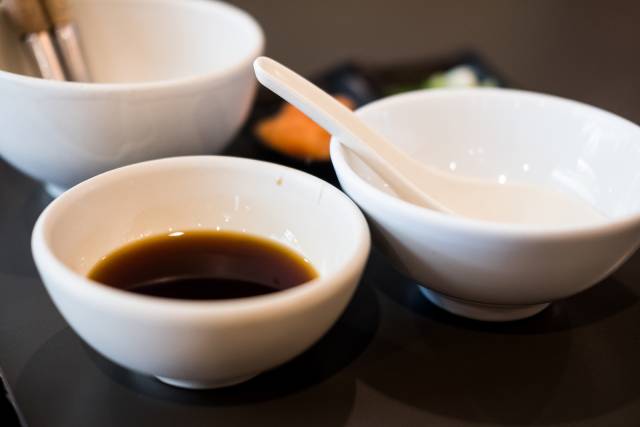
Ponzu sauce is a popular condiment from Japan that combines soy sauce with several other ingredients, including citrus juice, vinegar, and mirin, which is a sweet rice wine.
The sauce has an enjoyable and flavorful taste, with flavor notes of umami, sweet, and sour.
It tends to be used as a dip, but it also features as a flavor-enhancing ingredient in a wide range of dishes.
Per 16g tablespoon, ponzu offers the following nutritional values (44):
- Calories: 10 kcal
- Carbohydrate: 1.9 g
- Fiber: <0.1 g
- Sugars: 1.53 g
- Fat: <0.1 g
- Protein: 0.60 g
- Sodium: 400 mg
For more on the characteristics and nutritional properties of ponzu sauce, as well as some ideas on how to use it, see this guide:
What Is Ponzu Sauce? Characteristics, Nutrition Facts, Uses
27) Red Wine Vinegar
Red wine vinegar is an interesting condiment, and using it may have several benefits.
For instance, when we marinate steak (or any other meat) in red wine vinegar, the acid in the vinegar breaks down the meat’s muscle fibers. As a result, the vinegar has a tenderizing effect on the meat, which makes it softer (and tastier) after cooking.
Studies also show that consuming red wine vinegar alongside food may slightly reduce the body’s glucose response to carbohydrate-containing meals (45, 46).
To read more about red wine vinegar, see this link here.
Red wine vinegar also imparts a delicious, slightly fruity flavor to food.
Red wine vinegar is not a significant provider of any macronutrient, and it contains less than three calories per tablespoon (47).
28) Sauerkraut

Sauerkraut is a popular condiment made from fermented cabbage. Typically, people use a spoon or two of sauerkraut alongside their dinner or the main meal.
Interestingly, and in contrast to popular opinion, sauerkraut is not from Germany. Sauerkraut is very popular there, but it originated in China.
Although there is no proof, it is believed that Genghis Khan brought sauerkraut from Asia to Europe during the times of Mongolian conquests.
Sauerkraut has a refreshing taste and a crunchy texture. Due to the lactic acid bacteria it contains, it also has a slightly sour flavor.
It is also important to note that we can eat sauerkraut either hot or cold, but cooking it will kill the probiotic bacteria it contains (48).
Per standard one-ounce (28-gram) serving size, sauerkraut provides the following nutrients (49):
- Calories: 5 kcal
- Carbohydrate: 1.3 g
- Fiber: 0.8 g
- Sugars: 0.5 g
- Fat: 0 g
- Protein: 0.3 g
- Sodium: 185 mg
29) Salsa
Salsa is a delicious Mexican condiment, but it often contains unnecessary ingredients like vegetable oil and large amounts of sugar.
On the positive side, if we make it ourselves, we can include healthy ingredients and skip the rest.
For a quick and straightforward medium-strength salsa, we can use the following ingredients;
- 2 cups (400 g) tomatoes
- 1 large onion
- 5 cloves garlic
- 1/2 cup cilantro
- 1/2 tsp salt
- 2 tbsp freshly squeezed lime juice
- 2 jalapenos
The easiest way to make this is to add all the ingredients into a food processor and hit the ‘on’ button, but everything can be chopped and mashed manually if that is not an option.
Salsa is a good source of vitamins and the major polyphenol lycopene, and a typical nutrition profile per ounce (28.5 grams) is as below (50, 51):
- Calories: 9 kcal
- Carbohydrate: 1.8 g
- Fiber: 0.5 g
- Sugars: 1.0 g
- Fat: 0 g
- Protein: 0.3 g
- Sodium: 78 mg
There are many ways in which we can use salsa, but using it as a dip and stirring it into cooked dishes are the most typical usages.
30) Sesame Oil
Sesame oil is quite unusual in the way that it adds an amazing flavor to almost anything you add it to.
Most seed oils (otherwise known as “vegetable” oils) have an unappealing taste, but this one actually tastes good.
For this reason, numerous Asian dishes add a slight amount of the oil to dishes after cooking to enhance the flavor.
As a condiment, sesame oil is probably the best-tasting oil in the world.
Per teaspoon serving, sesame oil provides (52):
- Calories: 40 kcal
- Carbohydrate: 0 g
- Fiber: 0 g
- Sugars: 0 g
- Fat: 4.5 g
- Protein: 0 g
- Sodium: 0 mg
See this full guide to sesame oil for more on ways to use it and its potential benefits and drawbacks.
31) Sour Cream
Sour cream is another condiment that enjoys popularity in Mexico, and in combination with salsa and guacamole, we can find it in several famous Mexican foods.
However, Mexican food is far from the only way to use sour cream, and it is very adaptable.
For one thing, thickened sour cream mixed with several herbs makes a tasty sauce to top a variety of meat and fish-based meals.
On this note, salmon topped with a reduction sauce made from sour cream, salt, parsley, and dill tastes great.
Using sour cream on top of burgers and steak also works well.
Per two fluid ounce serving, sour cream contains (53):
- Calories: 108 kcal
- Carbohydrate: 2 g
- Fiber: 0 g
- Sugars: 2 g
- Fat: 11 g
- Protein: 1.2 g
- Sodium: 22 mg
Learn more: Sour Cream: Nutrition, Benefits, Downsides
32) Ssamjang
- Calories: 5 kcal
- Carbohydrate: 1.3 g
- Fat: 0 g
- Protein: 0.3 g
- Sodium: 185 mg
Ssamjang is another paste-like condiment of Korean origin, and it contains a wide range of foods.
On this note, the ingredient profile for ssamjang includes gochujang, fermented soybean paste, sesame oil, garlic, onion, and depending on the recipe, a small amount of sugar.
With this range of ingredients, Ssamjang has an interesting flavor that is salty, spicy, bitter, and mildly sweet at the same time.
Traditionally, ssamjang is used as a dipping sauce for raw vegetables and cooked meat.
Per tablespoon serving, ssamjang offers the following nutritional values (54):
- Calories: 40 kcal
- Carbohydrate: 8 g
- Fiber: 0 g
- Sugars: 4 g
- Fat: 0 g
- Protein: 2 g
- Sodium: 630 mg
33) Tahini
Tahini is a protein and fat-rich condiment typically used as a dip, spread, or topping.
Traditionally tahini has been a popular food in North Africa, the Middle-East, and some parts of the Mediterranean. However, it is now available throughout the world.
The production of tahini requires only one, or potentially two, ingredient(s): toasted sesame seeds and, if preferred, a little olive oil.
Per tablespoon (15-gram) serving, tahini provides high amounts of copper, manganese, phosphorus, and thiamin. Additionally, the basic nutrition profile looks like this (55):
- Calories: 89 kcal
- Carbohydrate: 3.2 g
- Fiber: 1.4 g
- Sugars: 0.1 g
- Fat: 8.1 g
- Protein: 2.6 g
- Sodium: 17 mg
For a complete nutritional guide to tahini, please refer to the article below:
Is Tahini a Healthy Choice? Nutrition, Benefits, Downsides
34) Tamari Sauce
Tamari is a kind of soy sauce, and it comes from Japan rather than China.
In contrast to the wheat, soy, and further ingredient mixture in traditional Chinese soy sauce, tamari should contain only three ingredients:
- Water
- Soybeans
- Salt
Tamari is not as salty as regular soy sauce, and it also has a slightly thicker texture.
Other than these differences, tamari and soy sauce have a similar visual appearance.
Tamari is a very popular condiment, and it is often used with raw fish in Japan.
Per tablespoon serving, tamari sauce contains (56):
- Calories: 11 kcal
- Carbohydrate: 1.0 g
- Fiber: 0.1 g
- Sugars: 0.3 g
- Fat: 0 g
- Protein: 1.9 g
- Sodium: 1006 mg
There are also a range of different soy sauce-based sauce options, such as shoyu (traditionally made soy sauce from wheat and soy) and ponzu sauce.
35) Wasabi
Wasabi is a green-colored Japanese condiment that people often enjoy in combination with raw fish and soy sauce.
Concerning its overall flavor, wasabi is one of the most potent condiments available, and eating a bit too much can lead to a burning sensation in our nose.
This burning feeling is actually due to a chemical in wasabi called allyl isothiocyanate. Interestingly, when we eat wasabi, this chemical reacts with—and irritates—the mucous membrane in our nasal cavities (57).
Per teaspoon serving of wasabi, the nutrient profile is as follows (58):
- Calories: 19 kcal
- Carbohydrate: 3 g
- Fiber: 0.4 g
- Sugars: 0.9 g
- Fat: 0.7 g
- Protein: 0.1 g
- Sodium: 220 mg
There are many different ways to use wasabi, but it loses its spicy flavor when exposed to heat.
Some good ways to use it include:
- As a topping on food
- To make spicy salad dressings
- Making a spicy dip alongside sour cream
36) White Pepper
For those who are unaware, white pepper and black pepper were once part of the same peppercorn.
The only difference is that the black outer skin has been removed, leaving only the inner white seed.
Similar to black pepper, ground white pepper is a popular condiment around the world, and it adds a lot of flavor to food, soups, stews, and sauces.
Just like black peppercorn, white pepper is also a good source of piperine (59).
Since the taste of white pepper is so strong, we only need to use a dash for a serving, which contributes little in the way of nutrients.
Final Thoughts
As this article shows, there are all sorts of tasty condiments out there.
Some of these can offer lots of flavor for minimal calories, and others can be quite high in sugar, fat, and calories.
However, all condiments can fit into a healthy overall diet, and they positively contribute to the overall taste of food. Some may even bring potential health benefits along too.

